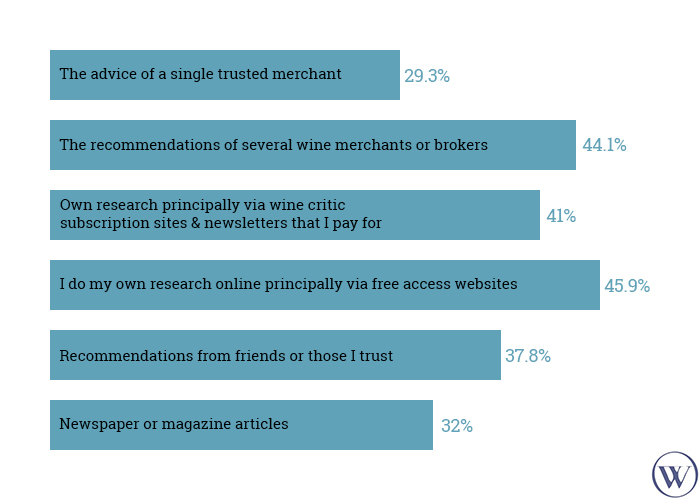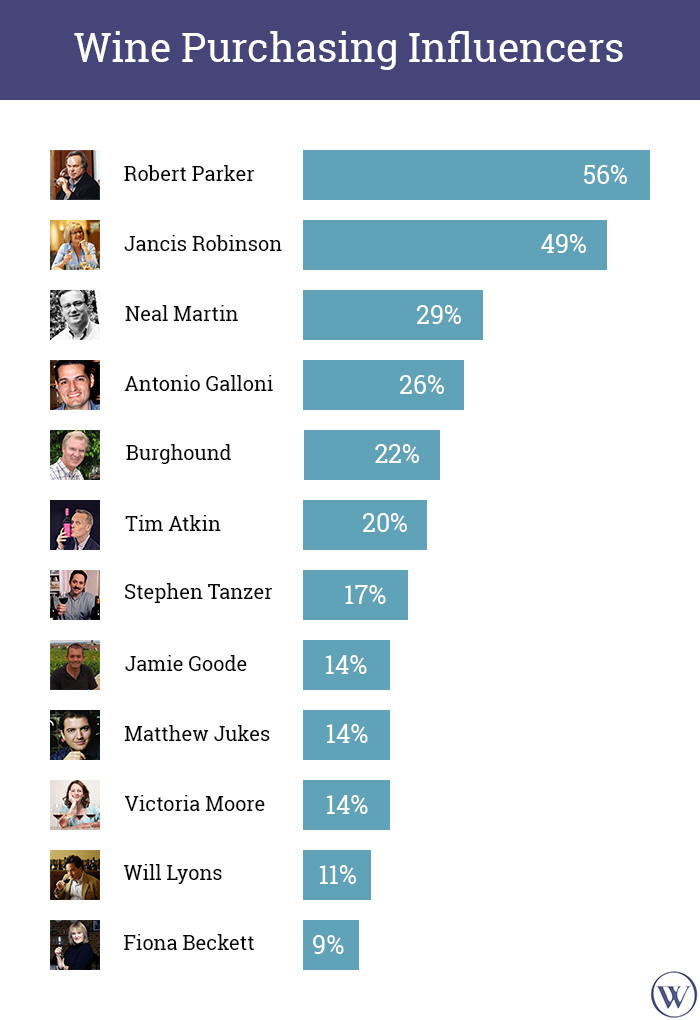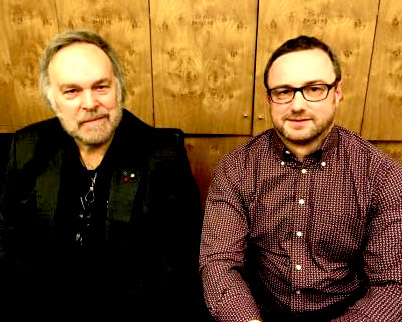by Wine Owners
Posted on 2015-06-07
Which wine writers exert the most influence over consumer purchasing decisions of fine wine?
It’s a question we’ve often been asked, and one we wanted to understand in context of what kind of recommendations influence consumers’ fine wine buying decisions.
To find out, we teamed up with Spiral Cellars, and organised a structured research programme through Effective Research. The fine wine purchasing influence ranking is based on 244 questionnaire responses.
We discovered that consumers rely on multiple recommendation sources, and even the least relied-upon source is quite significant in influencing purchases. This also suggests that social media influence is real, and can indirectly contribute towards buying decisions.

There is nonetheless a clear, favorable bias towards online sources, with the subscription sites of leading critics exerting the greatest sway over consumers.
Which critics and bloggers, if any, are you most likely to base a proportion of your buying decisions on?

When it comes to informing a proportion of buying decisions, Robert Parker is the clear winner with more than half of all respondents likely to buy based on his reviews. Neal Martin, his successor for new Bordeaux releases and leading Burgundy critic, is relied upon by 29% of respondents, with Jancis Robinson in a very strong second place position on 49%.
Vinous (Antonio Galloni on 26% and Stephen Tanzer on 17%) showed complementary strength, with Burghound (Allen Meadows) registering 22% and Tim Atkin on 20%.
Whilst consumers have their favourites, their buying decisions will be influenced by a number of critics and writers.
by Wine Owners
Posted on 2015-03-16
With Robert Parker handing over the reins of Bordeaux Primeurs tasting to Neal Martin, what are the implications?
The first, most obvious, change is Neal’s palate.
However objective a critic may be, his or her palate and personal preferences inevitably play a big part. Where Parker excelled was at getting his impressions across in a particularly accessible and descriptive way; not easy when tasting barrel samples. The temptation is to describe a wine in its elemental state elementally, which isn't that interesting to read. He described its future, and over the years demonstrated he was rather good at that.
His personal preferences may have veered towards a sunnier style of wine, but he tended to let the wine buyer know if a wine was stylistically towards one end of the spectrum or another. But it must be very hard to award a great score to a wine that doesn’t move you viscerally, and to that extent personal preferences must come into play.
Martin’s tasting preferences are naturally more European than Parker’s, and is perhaps more likely to be dazzled by finesse and complexity over power, texture and rich fruit. This is a gross oversimplification for sure, but perhaps suffice to say his evaluations will be his own.
The second is winemaking trends.
The trend back towards a more classical form of winemaking is already underway (allied to far better vineyard husbandry than was broadly the case when Parker started out – he is often attributed with raising standards). Use of new oak is being moderated at many Chateaux, and régisseurs are looking at ways to fully express and nuance their amazing terroirs, sub-plots and micro-climates whilst making the most of Bordeaux’s inherent ability to bear and bottle the most age-worthy wines in the world.
The tendency of the late 1980s and 1990s towards making and showing the kind of wines proprietors thought would garner the best scores early on is on the wane. If the world’s leading critics and evaluators of young Bordeaux favour a finer-boned vernacular, this will be reflected in the market, which is more likely than not to reward those styles of wine with the greatest demand.
The third change is context.
Back in the early 1980s there was no Internet, market transparency was therefore limited and the market was much narrower than today’s. Can another critic, however good, assume the same degree of importance and purchasing influence over a market in the way that Parker has achieved? If so, will they come from Europe or do they have to be American? Or Asian?
Will crowdsourcing views and reviews become a proxy for the next leading critic of his or her generation, a perspective that arises with the growing importance of the Internet? I wonder. Some may argue that buyers are too ready in our online age to trust the word of a virtual room-full of complete strangers over the words of an advisor or friend. Whilst such principles may work well for holiday destinations or white goods manufacturers, it’s tougher to see how this will ultimately prevail for the finest of fine wine. How experienced is the taster, do they have a bank of reference points in respect of tasting young wines, and can they draw parallels between what a wine tasted like when in barrel compared with 10-15 years on? Can they recognise the future evolution of a young wine, see similarities and differences, then context (and visualise) the next young wine they taste accordingly? What does it mean when experienced tasters say that great wine is born great? What does great taste like? What’s the palate preference of each taster; where on the spectrum do they sit?
That’s an awful lot of questions to ask of a crowd, especially when most of them have day jobs. Broadly, people may not care about all that of course; but people into their fine wine, and making spending decisions based on the judgement of others, will care. That’s why evaluators of fine wine such as Neal Martin, Jancis Robinson, Stephen Tanzer, Antonio Galloni, Tim Atkin, Will Lyons, and many other talented writers (see here) matter so much.
What could be somewhat significant in turning reputation and influence into market impact is the business model deployed. What I wonder is this: with the Internet capable of coalescing huge audiences and showing the true - often massively underestimated - size of market niches, will blanket subscription firewalls allow wine writers to maximise market influence?
How experts in general monetise their high value content may yet change over the next few years, perhaps in a parallel way that the music business experienced a profound shift from selling records to selling bums on seats and festival tickets. Will the experiential become the bigger money-spinner? How the world’s critics engage with their audience and allow them an element of participation and dialogue may prove decisive for the next Parker, if there is to be one. Being social web savvy can only but help.
The fourth change may be the end to ‘wait and see’.
If the Chateaux knew Robert Parker was coming to Bordeaux, they might hold off from releasing until his scores were known, and the job of negociant and merchant alike was simplified, if sometimes a little delayed.
When Parker didn't come to town within a few months of the new vintage, the market reflected the collective views of the wine industry that had tasted samples most frequently (producers, courtiers, negociants, importers) and added a dose of realism to do with the macro-economic context. Price differentials within a set of wines (e.g. First Growths) were narrower. So, famously, 1990 was priced cheaply in the recession of 1991 as was 2008 in the post-Lehmann, financially sclerotic environment of 2009.
In the short term at least, all the leading critics will turn up to taste on time and publish on time. The extent to which they will collectively or individually influence prices (and demand) remains to be seen, but it would be more surprising if they didn’t have at least some bearing on the market. Producers are more likely to have made up their mind on pricing based on their qualitative assessments early on, and perhaps we shall all be spared interminably long campaigns.

by Wine Owners
Posted on 2014-06-24
LONDON (June 24, 2014)
Wine Owners is now powering a newly-launched wine management and appreciation tool for The Wall Street Journal, WSJ Wine Portfolio.
The tool now allows users to discover wines, track individual prices over time, compare wines to indexes and other assets, and build an online portfolio to manage a cellar and track its value. With data provided by Wine Owners, the portfolio tool is available on The Wall Street Journal’s newly launched WSJ. Vintage which features columns, news and top picks by The Wall Street Journal’s award-winning columnists in Europe and the U.S., along with “one-minute wine” videos and an archive of articles on how to enjoy wine.
Key features of WSJ Wine Portfolio include:
• Discover – Readers can browse from the Wine Owners’ database of 160,000 wines to discover current market value, price history, producer profiles, and comparisons.
• Manage – Readers can organise and track the value of their fine wine collections.
• Analyse – Readers can value their wines and research wine prices over time. Those can be charted against other wines, indexes, and other asset classes.
Nick Martin, founder of Wine Owners, said, “We are delighted to be partnering with such respected global media brand as The Wall Street Journal. The platform will help readers manage their portfolios more proactively, and provide unparalleled visibility of their wine collections.”
“We see this as a natural extension to the rich wine coverage delivered by our award-winning columnists Will Lyons and Lettie Teague,” added Thorold Barker, Editor, Europe Middle East and Africa, The Wall Street Journal. “It allows our readers to engage with wine both for pleasure and as an investment.”


